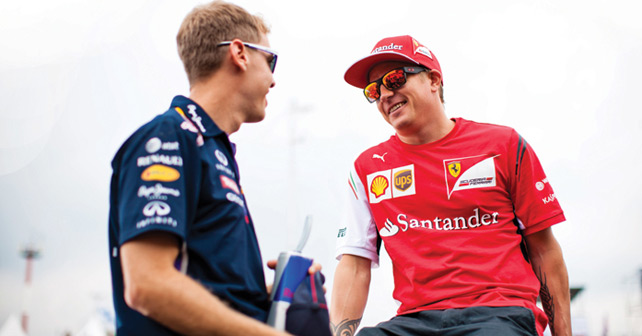Watching Sebastian Vettel and Kimi Raikkonen at work from 2012-13 makes their disappearance from the front of the grid a modern day F1 mystery.
The fact that the fortunes of Formula 1 drivers is linked to the competitiveness of their machinery is well known and has been the case since the very first F1 championship in 1950.
Within the swinging fortunes of a driver however, there has always been a way to gauge a driver’s worth. Whether it comes down to who their teammate is or how well they do in comparison to the dominant team of the season.
Over the course of their careers it was pretty clearly established that Sebastian Vettel and Kimi Raikkonen were more than a little special. In particular the way their careers started with a bang when the two were mere ‘youngsters’, at least until the next young gun comes along.
‘FINDING’ HIS CAR
Four straight F1 titles made it clear in the case of Vettel although in the opinion of team principals and many casual observers, Fernando Alonso was the best driver on the gird who was stuck in a relatively uncompetitive car. Much like the way Michael Schumacher’s troubles with his Ferrari magnified the difficulty of getting the better of Damon Hill, Jacques Villeneuve and Mika Hakkinen from 1996 to 1998.
After the way Vettel has been almost man-handled this season by teammate Daniel Ricciardo, his stock may have fallen a bit more, but give the guy some credit for winning four straight titles.
In the opinion of renowned racing driver coach Rob Wilson – whose gives examples of current F1 winners he himself has coached (including Raikkonen) to drivers back in the 1950s – racing drivers end to ‘find their cars’.
“He (Vettel) got so used to such a specific kind of car with a lot of downforce at the rear,” Wilson told autoX. “Vettel had complete confidence in that Red Bull much in the same way that Nigel Mansell could commit to the active suspension Williams and Ricardo Patrese was a bit scared to drive it as hard as him.
“In fact back when Red Bull used to run a diffuser that was not as effective from 2011 onwards, Mark Webber used to give him a much tougher time. Ricciardo had spent his career driving cars that did not have as much downforce at the rear and is much faster than Seb as a result.”
Wilson believes that Vettel will ultimately adapt to the new look F1 but may not be as dominant as he once was.
“Drivers find the cars that suit them best as a rule,” said Wilson. “James Hunt was the fastest driver in the world for 18 months with McLaren but then slipped into relative anonymity.
“Every now and again you have those rare drivers like Alonso who are fast and can produce a result no matter what team they are with.”
MAN OF FEEL
Being paired with a driver like that is bad enough for Raikkonen without losing the ‘feel’ for driving an F1 car that he so heavily relies on to be fast.
“Kimi is largely attatched to the feel of the car and that is missing now due to the brake-by-wire system for the rear brakes that are new this year due to the energy recovery requirements,” said Wilson. “He is not really adapting to the Ferrari very well although there have been instances where he has been fast and gotten the upper hand on Alonso who is a lot more engaged with the team.”
These travails of F1 champions is not a novelty in the sport and largely a result of the fortunes of a driver being linked to what team they race with and the strength of the technical package.
It is something that comes with the territory of a championship where there are enough variables for fans to argue till the cows come home about the merits and shortcomings of their heroes and favourite teams.
Vettel and Raikkonen are just the latest to be thrown under scrutiny.






















Write your Comment